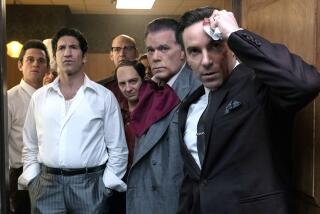MGM’s solution to a classic problem
Metro-Goldwyn-Mayer Inc. has found an economical solution for cash-strapped TV stations looking to fill their digital space: “Beach Blanket Bingo.”
Nearly eight months ago, the venerable movie studio created a low-cost programming service for television stations called This TV. Stocked with B-level films found deep within MGM’s vault, the venture serves up vintage fare like the 1960s beach movie with Frankie Avalon and Annette Funicello as well as TV shows such as “The Addams Family” and “The Patty Duke Show.”
“This is a great opportunity to take advantage of the digital transition,” said Jim Packer, MGM’s co-president of worldwide television.
On Friday, TV stations across the country completed the transition to all-digital broadcasts. The technology makes it possible to squeeze signals into a more compact slice of the spectrum, giving stations the ability to transmit several channels of programming -- instead of just one as was allowed under the old analog system.
The shift to digital TV, which had been in the works for two decades, was envisioned by the federal government as an opportunity for stations to provide comprehensive coverage of local news and sports, public affairs and multilingual programs on their digital sub-channels.
But a market to underwrite that vision has not materialized, and the lousy economy and crimped local advertising spending have not helped. During the last year, TV stations have cut costs and shed employees, leaving few resources to develop original programming that could be used to draw viewers to their digital channels.
“Programming the remainder of the digital spectrum is the last piece of the puzzle,” said Steve Ridge, president of media strategy for consulting firm Frank N. Magid Associates. “But everyone is wondering whether they can make money on it.”
The simplicity of MGM’s venture, a 24/7 offering of old movies and TV shows, has become one of its key selling points. MGM doesn’t charge for the service. Instead, it splits the ad revenue generated by This TV with the local television stations.
“It’s turn-key,” MGM’s Packer said. “Stations can turn the switch and have a new channel.”
Deana Myers, television analyst with media research firm SNL Kagan, said the recession “in some ways makes this an opportune time for MGM to launch This TV,” she said. “I just don’t know how much money they are going to get from the stations right now.”
The concept was hatched over coffee in Las Vegas at the annual TV syndication convention in January 2008. Neal Sabin, a Chicago station executive, was discussing the need for programming for digital channels with John Bryan, MGM’s executive vice president for broadcast strategy.
Within 10 months, This TV was on the air. Sabin’s company, Weigel Broadcasting Co., which owns stations in Chicago, Milwaukee and South Bend, Ind., is MGM’s venture partner. MGM provides the movies and Sabin -- who has a soft spot for vintage TV -- schedules the service and comes up with program themes such as “This Is Vincent Price” or “This Is Macho,” featuring Clint Eastwood films.
“We do everything from classics to campy,” Sabin said. “We were coming at this as a station that has made it work. And we knew how to do it without adding a lot of staff.”
MGM says the service is available in about 80 million homes. But viewers in those households may have a hard time finding This TV because in some regions, including Los Angeles, the service is available via over-the-air signal but is too new to be included in programming packages offered by cable and satellite TV providers.
In Los Angeles, viewers who rely on an antenna for broadcast TV can find This TV as a sub-channel of KTLA-TV Channel 5. The channel is not yet distributed by Time Warner Cable Inc. or DirecTV Corp. (KTLA is owned by Chicago-based Tribune Co., which publishes the Los Angeles Times.)
The challenges of getting carriage on pay TV services highlight the problem faced by television stations developing strategies for their digital channels. Without the larger audience pool of cable subscribers, it could be difficult for ventures to attract enough viewers to produce ratings that generate sizable ad revenue.
This TV has a slight edge: One of MGM’s owners is Comcast Corp., the nation’s largest cable company. This TV is already on some of Comcast’s cable systems.
MGM’s Packer noted that there are millions of Americans who still get free over-the-air television. SNL Kagan estimates that 15% of U.S. homes with TVs do not subscribe to a pay service. Thus, those viewers don’t have access to Turner Classic Movies, TNT, AMC and other cable channels that play old movies.
The other advantage of This TV is that stations can provide their own programming, lending local flavor. Stations can cross-promote their newscasts or broadcast other local events, such as film festivals.
“It is like a national independent that can be localized,” said MGM’s Bryan.
In March, independent station WMOR-TV in Tampa, Fla., began carrying the service.
“We fell in love with the concept. It has been easy to sell to advertisers,” said Ken Lucas, the station’s general manager. Already, he said, the largest Buick and Pontiac dealership in Tampa has sponsored the network and the station quickly achieved initial revenue goals.
“It has a true network feel and the quality is good,” Lucas said. “And it’s a great family network. MGM has over 4,000 movies, many of the best of the best. Viewers love it.”
--
More to Read
The biggest entertainment stories
Get our big stories about Hollywood, film, television, music, arts, culture and more right in your inbox as soon as they publish.
You may occasionally receive promotional content from the Los Angeles Times.











